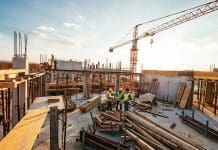Housing, infrastructure and transport gain significant investment following the government’s Autumn Statement
This afternoon Philip Hammond delivered his first (and last) Autumn Statement as Chancellor. There was, as expected, considerable focus on housing—an area that undoubtedly continues to be at the forefront of both government policy and public concern.
Infrastructure seemed to get a good mention, with planning matters left somewhere by the wayside. The main theme of the Autumn Statement related to productivity and ensuring greater improvements in this area.
So how will this impact the construction sector?
Undoubtedly there are positives to be found within the Autumn Statement, although still a number of question marks.
National Productivity Investment Fund
One of the key components of the speech was the launch of the National Productivity Investment Fund. This will be targeted at four areas the government considers critical for improving productivity:
- Housing
- Transport
- Digital communications
- Research and development (R&D)
A total of £23bn spending will be provided through the fund between 2017-18 and 2021-22. The fund, the government said, will take total spending on housing, economic infrastructure, and R&D to £170 billion over the next 5 years.
The NPIF aims to accelerate new housing supply; tackle congestion on the roads and ensure the UK’s transport networks are fit for purpose; support the market to roll out full-fibre connections and future 5G communications, delivering a step change in broadband speed, security, and reliability; and enhance the UK’s position as a world leader in science and innovation.
Housing
As expected the Housing White Paper was not published today, but with the footnote “shortly”. When the document is published it will set out a comprehensive package, aimed at reforming the sector to ensure an increase in housing stock while improving affordability.
To help with this the government announced a new £2.3bn Housing Infrastructure Fund by 2020-21. This will be funded by the NPIF and allocated to local government, helping to develop private housebuilding in areas most at need. The government said this fund will deliver up to 100,000 new homes.
As expected before the speech, affordable homes will also gain a boost. £1.4bn investment will deliver an additional 40,000 housing starts by 2020-21.
Furthermore, Right to Buy will undergo a large-scale regional pilot for housing association tenants. This will expand the scheme to over 3,000 tenants under the pilot.
Delivering the Autumn Statement this afternoon, Hammond said: “Mr Speaker, this package means that over the course of this Parliament, the government expects to more than double, in real terms, annual capital spending on housing.”
He added: “This commitment to housing delivery represents a step-change in our ambition to increase the supply of homes for sale and for rent, to deliver a housing market that works for everyone.”
Russell Gardner, Head of Real Estate at EY, said the measures did not go far enough to tackle the shortage of affordable homes.
“Measures to address the UK’s housing supply crisis are welcome, but must represent the start of a major commitment to building significantly more homes across the UK,” he said.
“The headline numbers are eye-catching but it requires a stretch of the imagination to believe that new homes supply can be unlocked for £23,000 each or an affordable house can be built for £35,000.
“We eagerly await the Housing White Paper and hope it contains more radical structural proposals.”
Charlotte Cook, a Partner at law firm Winckworth Sherwood said it would be interesting to see how this money would be spent.
“Previous chancellors and housing stimuli have tended to focused on first time-buyers, and whilst they do need assistance the Government needs to focus more on later life buyers and occupiers.”
“By 2020 it is estimated that there will be some 20m people aged over 60. Even now, there are more over 60s in the UK and there are under 18s.
“The Government’s housing policy does not adequately reflect that. And whilst social housing providers and local government are responding, much greater choice of housing and tenure is needed.”
Public Sector Land
The government announced in October it would run a pilot scheme aimed at accelerating construction on public sector land. Hammond revealed in his speech some £1.7bn will be invested through the NPIF. This will, Hammond said, speed up house building.
“In October, my Right Honourable Friend, the Communities Secretary launched the £3 billion Home Builders’ Fund, to unlock over 200,000 homes and up to £2 billion to accelerate construction on public sector land,” Hammond said.
“But we must go further still. The challenge of delivering the housing we so desperately need in the places where it is currently least affordable is not a new one. But the effect of unaffordable housing on our nation’s productivity makes it an urgent one.”
Michael Thirkettle, Chief Executive of leading interdisciplinary international construction and property consultancy McBains Cooper, said it was good news the government had committed to spending on social and economic infrastructure, but expressed regret there was little mention of the planning process.
“We are disappointed that there was no announcement to streamline the planning process or free up land on the greenbelt – much of which is derelict land rather than areas of beauty – as that would also help the shortage of land.”
Infrastructure
The National Infrastructure Commission (NIC) also got a mention in the Autumn Statement. The government announced it has set the NIC a fiscal remit. Investment will rise across the areas NIC covers to over one per cent of GDP by 2020-21. The NIC have been asked to set out recommendations on the assumption spending on infrastructure will lie between 1 and 1.2 per cent of GDP each year from 2020 to 2050. Final spending decisions will lie with the government.
“Today I have written to the National Infrastructure Commission to ask them to make their recommendations on the future infrastructure needs of the country,” Hammond admitted.
“Using the assumption that government will invest between 1 per cent and 1.2 per cent of GDP every year from 2020 in economic infrastructure covered by the Commission.
“To put this in context, we’ll spend around 0.8 per cent of GDP on the same definition this year.”
Additionally, the government said it has asked the NIC to look into how emerging technologies can improve infrastructure productivity.
Hammond also put his support behind some of the recommendations laid out by the NIC in an interim report relating to the Oxford-Cambridge growth corridor.
“I am also backing the Commission’s interim recommendations on the Oxford-Cambridge growth corridor published last week with £110m of funding for East West Rail, and a commitment to deliver the new Oxford to Cambridge Expressway.
“But this project can be more than just a transport link. It can become a transformational tech-corridor, drawing on the world-class research strengths of our two best-known universities.
“So I welcome the Commission’s continuing work on delivery model options, and we will carefully consider its final recommendations in due course.”
Transport
Through the NPIF roads and local transport will also gain a boost, with the fund providing an additional £1.1bn investment by 2020-21. This money will be used to relieve congestion and deliver upgrades to local roads, as well as public transport.
An extra £220m will be invested to tackle key pinch-points on strategic roads.
“Reliable transport networks are essential to growth and productivity,” Hammond said in his speech.
“So this Autumn Statement commits significant additional funding to help keep Britain moving now, and to invest in the transport networks and vehicles of the future.”
Flood defences
Flooding, which has been a major problem across some regions in the UK, will also gain a boost. Some £170m will be put aside for flood defences and resilience measures. This will be split, with £20m investment being spent on new flood defence schemes, £50m for rail resilience projects, and £100m to improve the resilience of roads to flooding.
Duncan Tilney, managing associate in the Planning and Infrastructure team at Bond Dickinson said: “While he [the Chancellor] steered away from referring to particular projects, the small print does include confirmation of £170 million investment in flood defence and resilience measures. With £20 million of this for new flood defence schemes, £50 million for rail resilience projects, including Dawlish, and £100 million to improve the resilience of roads to flooding. This is welcome.”
The full Autumn Statement can be found here: https://www.gov.uk/government/publications/autumn-statement-2016-documents/autumn-statement-2016
The full speech can be found here: https://www.gov.uk/government/speeches/autumn-statement-2016-philip-hammonds-speech













